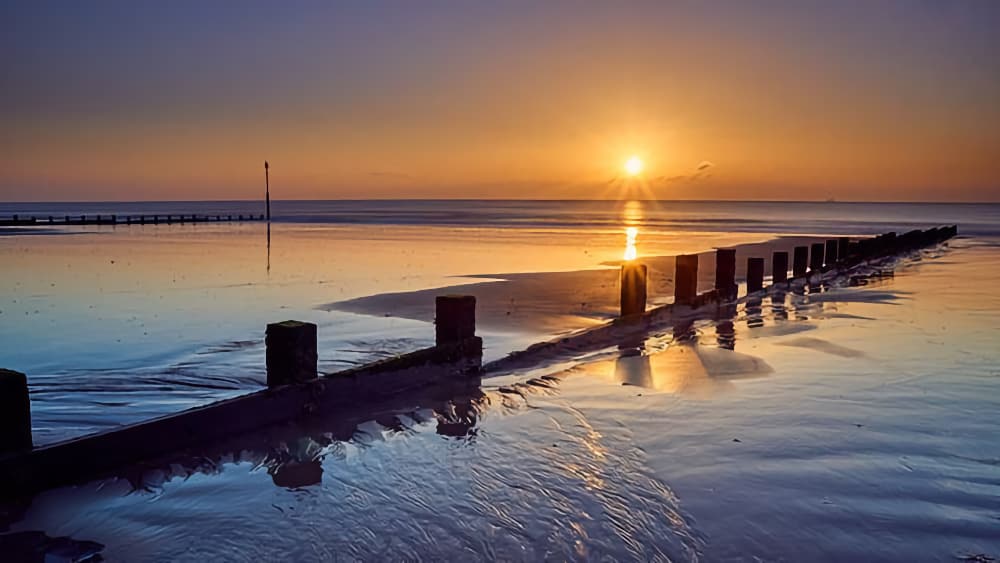- Home
- All Walks · Walking Routes
- Walks by Region
- Walks in South East England
- Walks in Kent
- The Romney Marshes Walk, Kent
Click to zoom …
Walk Details
This lovely circular walk features include the Romney, Hythe and Dymchurch light railway; Martello Towers; the well appointed church at St. Mary in the Marsh and the literary associations with that small village; the Marshes; a seafront finale or the option of a railway ride.
We are starting from the large car park just beyond the Ocean Inn, on the seafront road (A259) at Dymchurch.
In the car park is one of the surviving 26 Martello Towers – named after a similar construction at Cape Martello, Corsica that successfully thwarted an attack by the British in 1794. Originally, 74 towers were constructed. Each housed 24 men within the six foot thick walls on the first floor.
Supplies and ammunition etc. were stored at ground level. The roof housed a rotating canon. Martello Towers and the Royal Military Canal were constructed in the early part of the 19th century, when the threat of invasion by Napoleon loomed.
We leave the car park, cross over and turn right. At the roundabout turn we’re going left into Mill Road, walking beyond Dr. Syn’s restaurant to enter East Bridge Road. Crossing over the narrow gauge railway (Dymchurch station to the left), we continue along the road seeking a waymarker and footbridge on the left – opposite house 23. Cross the footbridge and then we veer diagonally right across the field, towards a stile hidden behind the blackthorn bushes and proceed straight ahead, towards a tiny building.
The building is one of the 12 surviving ‘lookers huts’ of which 356 were originally built. These housed ‘lookers’, men who tended the marshland sheep. Note the dipping trough alongside the building. In common with several marshland churches, these ‘huts’ were built on rafts of artificially raised ground to prevent flooding.
From the hut, we cross over the next field (houses on the right) and make for a wide gate and attendant stile, then continue alongside a ditch to cross another stile. Crossing the next field walking directly towards a waymarker and footbridge, we then proceed straight ahead along the edge of a cultivated field with a ditch on the left – if you’re here in the spring, pause for a moment and notice the air filled with the sound of skylarks.
We pass an upright waymarker, then swing right at a confluence of ditches to arrive at another footbridge and yellow marker. Crossing the bridge, we then veer slightly right across the field towards another footbridge. Depending on the time of year you’re here – if tall crops make it impossible to cross the field, carry on alongside the ditch. Cross the bridge and then we turn left to walk 200m along a green swathe towards another waymarker and footbridge. Cross this, then continue straight ahead following an obvious track across the field (50m) before swinging left, to walk with a ditch to the right and onto another footbridge.
The widest ditches in this part of the country are known as ‘sewers’ – vital in the movement of water across the marshes for the purpose of irrigation and drainage. The sewers flow towards sluice gates allowing water to empty into the sea. One of these sluice gates can be seen opposite the start/finish point. The sewers also link up with the Royal Military Canal.
From the footbridge we cross the field (diagonally right). We’re aiming for the telegraph pole to the left of St. Mary’s church spire then onwards to the final footbridge and a stile directly ahead. Reaching the road turn left and take the first turning right – signposted St. Mary in the Marsh.
The church dates from about 1130, although the spire was added to the tower some considerable time later. Edith Nesbit, author of The Railway Children is buried in the churchyard. Noel Coward wrote one of his early plays – The Vortex, while resident in the village. The Star makes a convenient half way stop, especially if you’re in need of some refreshments.
When you’re ready, we pass through the gate alongside the pub and follow the perimeter fence, veering left towards a stile. From here we need to maintain the same line across the next field, crossing a footbridge (telegraph pole), then proceed straight ahead and locate another footbridge situated among the hedging. Walk across another field (large barn away to the left) and cross over the road.
Walk along a clear green swathe (soon accompanied by trees on the right) and cross a footbridge. Cross the next field aiming slightly left, towards another footbridge. This is surrounded by hawthorn bushes situated between telegraph poles. Again if the route proves impassable due to crops – just follow the ditch on the right.
Cross the next field (uncultivated) passing beneath the power lines, and gradually drift right towards a stile (tall tree and pond). Beyond this stile we veer right and pass a dilapidated sheepfold and another stile. Continue straight ahead, passing through an opening in a curved fence and follow a green swathe, (ditch about 20m to the right) towards a final stile leading into a track.
Reaching a road (Jefferstone Lane), we turn left towards Jefferstone railway station or the seafront, depending on your choice of return. At the seafront turn right, cross over (pelican crossing) then turn left along the sea wall back to the car park.
The Romney, Hythe and Dymchurch Light Railway was the dream of two racing drivers: Captain J Howey and Count Zborowski. The Count was fatally injured in a crash in Italy, leaving the Captain to continue alone. Later the Southern Railway Co. were involved and the 14 miles of 15’ gauge track became operational in 1929. The modern (1995) sea wall was built about 2 feet (60 cms) higher than the 1930s wall.
 Nearest Train (or tube) Station(s):
Nearest Train (or tube) Station(s):
St Mary’s Bay, Ashford
Read the Countryside Code before venturing out
Make sure to take a map and compass, and know how to use them before going into our National Parks #BeAdventureSmart
Tips for New Walkers: click here to download (PDF).
Remember to prepare properly before heading out on any type of walk or outdoor activity. Tell people where you are going and what time you are expected back. As Wainwright says "There's no such thing as bad weather, only unsuitable clothing".



















